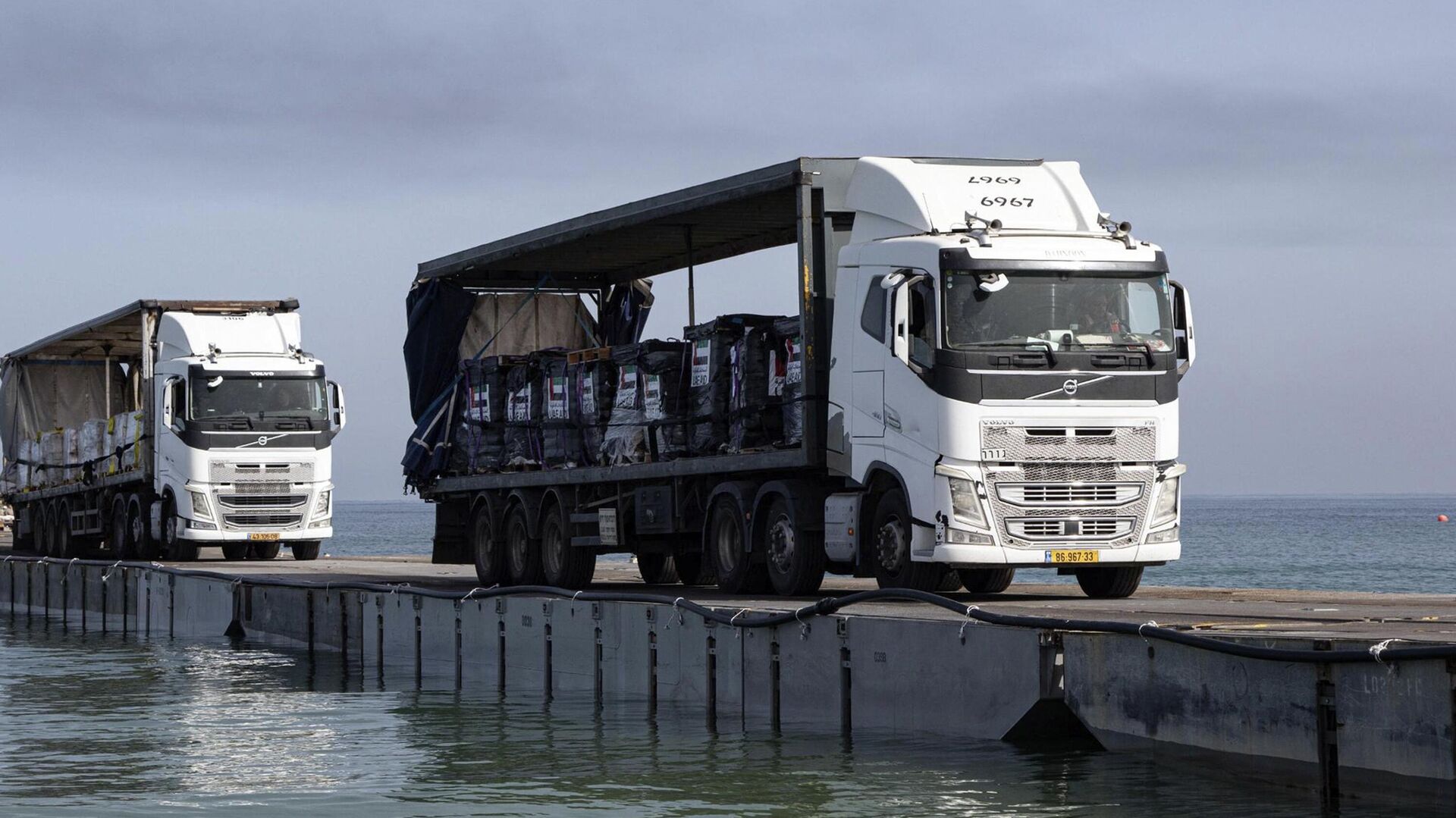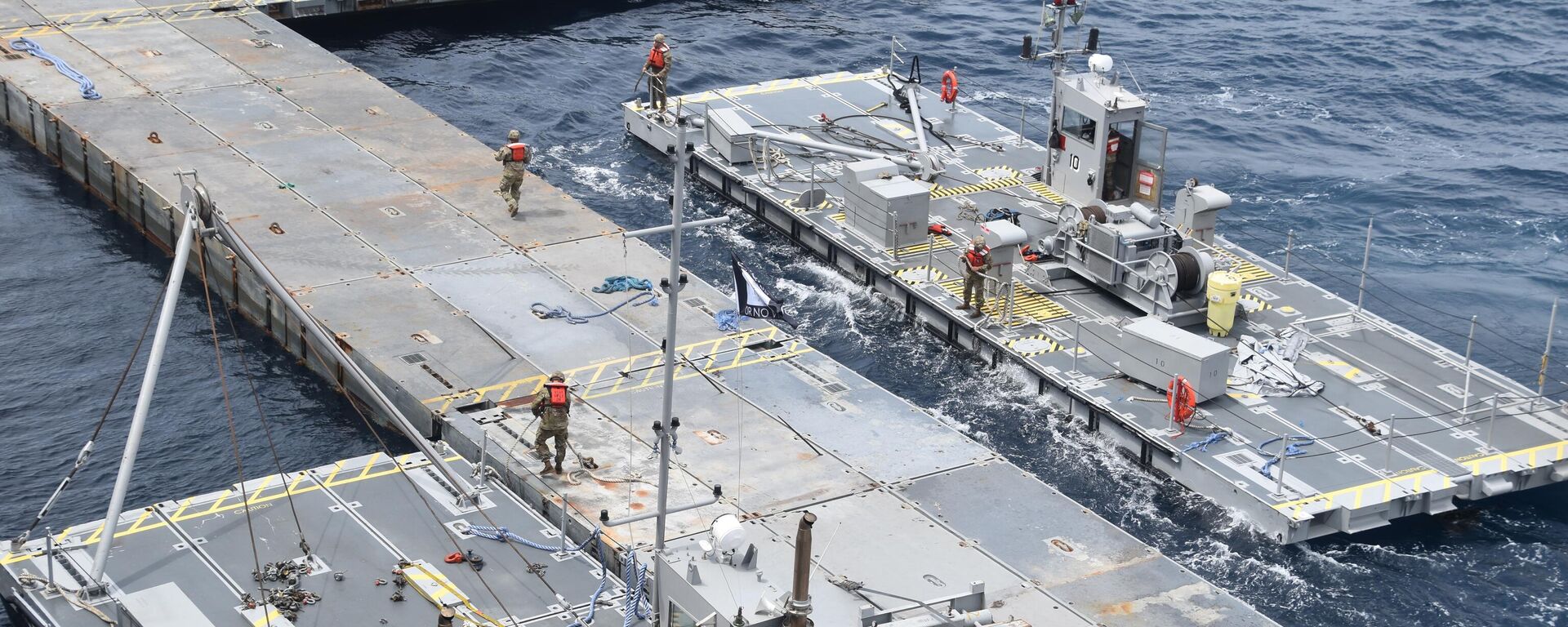https://sputnikglobe.com/20240623/miscalculated-stormy-seas-expose-pentagons-floating-gaza-aid-pier-as-feeble-flop-1119075334.html
‘Miscalculated': Stormy Seas Expose Pentagon's Floating Gaza Aid Pier as Feeble Flop
‘Miscalculated': Stormy Seas Expose Pentagon's Floating Gaza Aid Pier as Feeble Flop
Sputnik International
The floating pier built by the US military for humanitarian deliveries to Gaza turned out to be nothing but a wasteful boondoggle due to simple “miscalculations.”
2024-06-23T12:32+0000
2024-06-23T12:32+0000
2024-06-23T12:32+0000
palestine-israel conflict
gaza strip
pier
humanitarian aid
world
palestinians
joe biden
israel
rafah
pentagon
https://cdn1.img.sputnikglobe.com/img/07e8/06/17/1119074378_0:142:2998:1828_1920x0_80_0_0_48eed1621b3489fea076af8fb3cbd088.jpg
The floating pier built by the US military for humanitarian deliveries to Gaza turned out to be nothing but a wasteful boondoggle due to simple “miscalculations.”“They just miscalculated… They didn’t fully understand what was going to happen with the weather … So the DoD [Department of Defense] walks away, humiliated in a fashion,” Stephen Morrison, a senior vice-president at the Center for Strategic and International Studies, was cited as saying by The Guardian.The $230 million-worth project conceived by the Pentagon turned out to be too fragile to handle rough seas and, furthermore, has been plagued by poor security. Its very future is now in question.It took over two months, 1,000 US troops, and multiple US Navy vessels to construct the Joint Logistics Over-the-Shore (JLOTS) facility. This consisted of a floating dock deployed at sea and a corresponding pier attached to the Gaza coast. Despite being operational since May 17, the maritime corridor was only functional for just 12 days. As a result, only 250 truckloads of humanitarian aid have been delivered through the vulnerable pier.Poor security meant that arriving aid was dumped on the beach on most of the days because there were no trucks to take it from the pier to warehouses in the enclave.Convoys tasked with delivering the aid have been suspended by the World Food Programme, with the international organization's security review still ongoing.The floating structure was designed to withstand “sea state 3” conditions, or, in other words, waves of 0.5 to 1.25 meters tall. However, an unruly eastern Mediterranean had generated a storm on May 25 that gave the pier a serious battering. After being towed away for repairs to the Israeli port of Ashdod, it resumed operation on June 8, but just a day later aid deliveries were suspended for two more days. Rough weather forced the pier to be dismantled again on June 14.It’s an easy guess that more such setbacks will follow, as the construction is just too vulnerable to the elements.Despite “tactical pauses” introduced by Israel to allow aid in, security conditions are described as appalling. The Rafah crossing from Egypt has been closed since May 7, when the IDF launched its Rafah offensive. The roads to the Keren Shalom border crossing in southern Israel are too dangerous due to both IDF attacks on Hamas in Gaza, and looting by gangs.Nevertheless, despite being plagued by problems, the maritime pier was described as a “critical additional conduit for aid deliveries” by a US official. Department of Defense Press Secretary Maj. Gen. Patrick Ryder said that, “no end date has yet been established for this mission, contrary to some press reporting on the matter.”When the concept for the pier was unveiled during Joe Biden’s State of the Union address in March, it was trotted out as a symbol of the US president’s ostensible concern for the plight of Palestinians in Gaza. Since Israel curbed the entry of aid convoys through the land crossings, the pier was designed to help increase the flow of food into the besieged enclave. However, critics pointed out that the project was meant to serve as a “humanitarian cover” of sorts for Biden’s support of Israel.
https://sputnikglobe.com/20240507/is-biden-pushing-for-another-nakba-with-gaza-aid-pier-ploy-1118298323.html
gaza strip
israel
rafah
Sputnik International
feedback@sputniknews.com
+74956456601
MIA „Rossiya Segodnya“
2024
News
en_EN
Sputnik International
feedback@sputniknews.com
+74956456601
MIA „Rossiya Segodnya“
Sputnik International
feedback@sputniknews.com
+74956456601
MIA „Rossiya Segodnya“
us aid pier military usage, us anti-drong tech gaza, us testing gaza, biden humanitarian aid pier weapons, gaza devastation, israel-palestine conflict, palestine-israel conflict, israeli-palestinian conflict, palestinian-israeli,
us aid pier military usage, us anti-drong tech gaza, us testing gaza, biden humanitarian aid pier weapons, gaza devastation, israel-palestine conflict, palestine-israel conflict, israeli-palestinian conflict, palestinian-israeli,
‘Miscalculated': Stormy Seas Expose Pentagon's Floating Gaza Aid Pier as Feeble Flop
The US-built giant floating pier started operating on May 17, but appears to have been out of service most of the time. The much-touted humanitarian project has failed to replace land routes as a way to deliver aid to the beleaguered Gaza Strip amid Israel's war on Hamas.
The
floating pier built by the US military for humanitarian deliveries to Gaza turned out to be nothing but a wasteful boondoggle due to simple “
miscalculations.”
“They just miscalculated… They didn’t fully understand what was going to happen with the weather … So the DoD [Department of Defense] walks away, humiliated in a fashion,” Stephen Morrison, a senior vice-president at the Center for Strategic and International Studies, was cited as saying by The Guardian.
The $230 million-worth project conceived by the Pentagon turned out to be
too fragile to handle rough seas and, furthermore, has been plagued by poor security. Its very future is now in question.
It took over two months, 1,000 US troops, and multiple US Navy vessels to construct the Joint Logistics Over-the-Shore (JLOTS) facility. This consisted of a floating dock deployed at sea and a corresponding pier attached to the Gaza coast. Despite being operational since May 17, the maritime corridor was only functional for just 12 days. As a result, only 250 truckloads of humanitarian aid have been delivered through the vulnerable pier.
Poor security meant that arriving aid was dumped on the beach on most of the days because there were no trucks to take it from the pier to warehouses in the enclave.
Convoys tasked with
delivering the aid have been suspended by the World Food Programme, with the international organization's security review still ongoing.
The floating structure was designed to withstand “sea state 3” conditions, or, in other words, waves of 0.5 to 1.25 meters tall. However, an unruly eastern Mediterranean had generated a storm on May 25 that gave the pier a serious battering. After being towed away for repairs to the Israeli port of Ashdod, it resumed operation on June 8, but just a day later aid deliveries were suspended for two more days. Rough weather forced the pier to be dismantled again on June 14.
It’s an easy guess that more such setbacks will follow, as the construction is just too vulnerable to the elements.
Despite “
tactical pauses” introduced by Israel to allow aid in, security conditions are described as appalling. The Rafah crossing from Egypt has been closed since May 7, when the IDF launched its
Rafah offensive. The roads to the
Keren Shalom border crossing in southern Israel are too dangerous due to both IDF attacks on Hamas in Gaza, and looting by gangs.
Nevertheless, despite being plagued by problems, the maritime pier was described as a “critical additional conduit for aid deliveries” by a US official. Department of Defense Press Secretary Maj. Gen. Patrick Ryder said that, “no end date has yet been established for this mission, contrary to some press reporting on the matter.”
When the
concept for the pier was unveiled during Joe Biden’s State of the Union address in March, it was trotted out as a symbol of the US president’s ostensible concern for the plight of Palestinians in Gaza. Since Israel curbed the entry of aid convoys through the land crossings, the pier was designed to help increase the flow of food into the besieged enclave. However, critics pointed out that the project was meant to serve as a
“humanitarian cover” of sorts for
Biden’s support of Israel.



